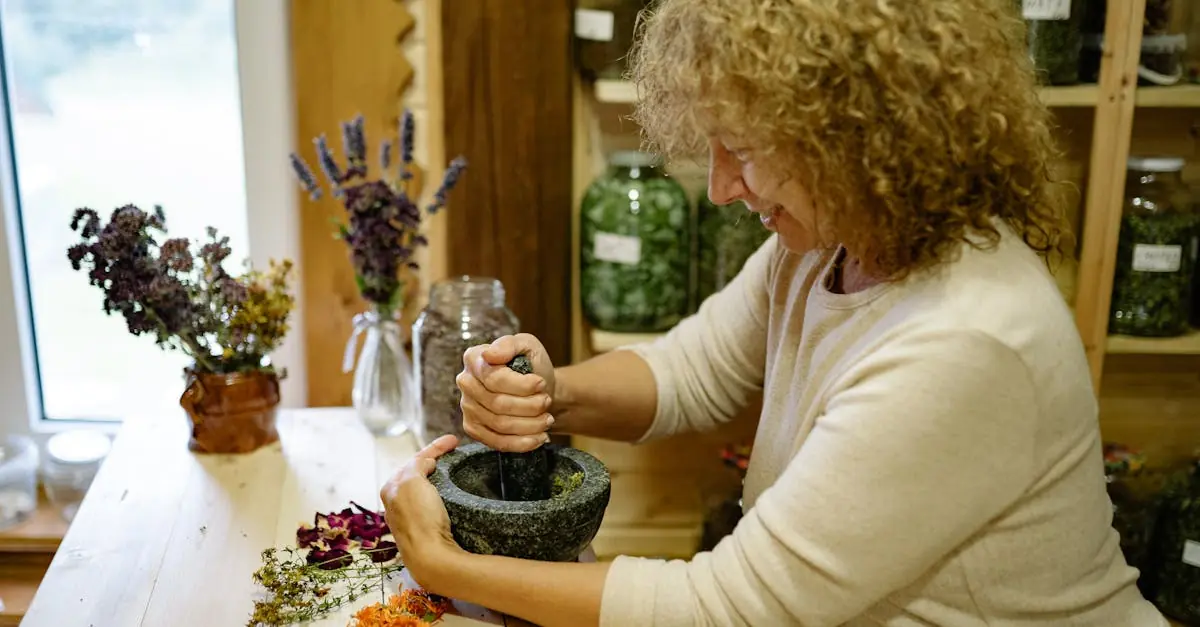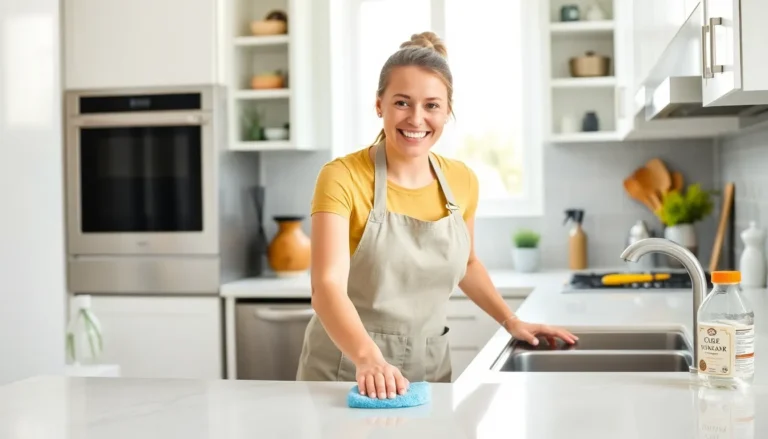Transforming old kitchen cabinets into a stylish sideboard might sound like a DIY dream, but it’s easier than you think. Think of it as giving your cabinets a second chance at life, minus the mid-life crisis. With just a little creativity and elbow grease, those forgotten cabinets can become the centerpiece of your dining room, holding everything from fancy china to that collection of takeout menus you just can’t let go of.
Table of Contents
ToggleOverview of DIY Sideboards
DIY sideboards crafted from kitchen cabinets offer a unique opportunity to enhance home decor. This transformation reflects a growing trend toward sustainable design, as individuals repurpose materials to create stylish furniture. Kitchen cabinets provide the perfect base due to their durable construction and ample storage space.
An attractive sideboard not only serves practical purposes but also adds character to a dining room. Using cabinets allows for customization in terms of size, color, and finish. Potential materials include painted wood finishes, stain applications, or even a distressed look that adds charm.
The basic steps involve selecting the right cabinets, preparing them through sanding and priming, and finally painting or staining them for a finished appearance. Adding hardware, like knobs or handles, can elevate the overall design. They can also include additional features such as open shelving or glass doors to showcase decorative items.
Choosing the correct location is essential for functionality and aesthetic appeal. Positioning the sideboard against a wall allows efficient access while serving as a decorative focal point. All these aspects come together to create a viable and appealing solution for those looking to elevate their living spaces and maximize available resources.
Revitalizing old cabinets not only clears clutter in the kitchen but also contributes to a personalized home environment. Achieving this transformation encourages creativity and resourcefulness, providing an economical option for stylish and functional furniture.
Benefits of Using Kitchen Cabinets
Using kitchen cabinets for a DIY sideboard offers multiple advantages. Cost savings and sustainability rank high among these benefits.
Cost-Effective Solution
Repurposing old kitchen cabinets turns out to be budget-friendly. They often come at a lower cost compared to purchasing new furniture. Homeowners can save significant money by utilizing what they already possess. This approach eliminates the need for expensive materials and labor. Furthermore, many old cabinets can be found inexpensively at garage sales or thrift shops. Creating a custom sideboard from these cabinets minimizes expenses while maximizing value.
Sustainable Choice
Opting to use kitchen cabinets supports eco-friendly practices. Many consumers prioritize sustainability as they aim to reduce waste. Repurposing cabinets prevents them from ending up in landfills, promoting recycling. This practice contributes to a more sustainable environment by extending the lifecycle of materials. Additionally, personalizing a sideboard from existing cabinets reduces the demand for newly manufactured items. By choosing this route, individuals align their home improvement projects with environmentally conscious values.
Planning Your DIY Sideboard
Planning is essential for a successful DIY sideboard project. It ensures that the final design meets the intended functionality and aesthetic.
Choosing the Right Cabinets
Selecting the ideal cabinets is crucial for the sideboard’s overall look and function. Many homeowners opt for solid wood cabinets due to their durability and timeless appeal. Others might choose laminate options for a sleek finish or to match existing decor. Repurposed cabinets from kitchen remodels or secondhand stores often provide budget-friendly choices. Assess the condition of potential cabinets, focusing on structural integrity and overall appearance. Consider cabinets with unique features such as glass doors or interesting designs that can enhance the sideboard’s charm.
Measuring Your Space
Accurate measurements play a vital role in creating a well-fitting sideboard. Begin by determining the designated area for the new piece. Measure the height, width, and depth of the space to ensure a seamless fit. Leave room for adjustments, such as additional decor or clearance for doors. Evaluating the surrounding furniture allows for better integration into the existing layout. Visualizing the sideboard’s placement helps identify the best position for functionality and aesthetics. Consider measuring at different heights, especially if planning for adjustable shelving, to maximize storage options.
Step-by-Step Guide to Assembling
Assembling a sideboard from kitchen cabinets requires careful steps to ensure a polished result. Follow the outlined instructions for a successful transformation.
Preparing the Cabinets
Begin by cleaning the cabinets thoroughly to remove any dirt or grease. Inspect the structure next, searching for damages or weaknesses that may need repairs. Sand the surfaces to create a smooth finish, preparing it for paint or stain application. Select a primer suited for the material, applying it evenly over all surfaces. After letting it dry, choose a color or finish that complements your design vision, ensuring to apply multiple coats for even coverage.
Adding Finishing Touches
Enhancing the sideboard’s style involves selecting the right hardware. Choose knobs and pulls that match the overall aesthetic you aim for. Installing open shelving or incorporating glass doors can add visual interest and functionality. Consider adding protective pads to the bottom to prevent scratches on your flooring. Once the hardware is securely attached, review the entire piece for any final adjustments needed, ensuring everything aligns perfectly.
Styling and Decor Ideas
Transforming a sideboard from kitchen cabinets opens up a world of styling possibilities. Creating a visually appealing piece enhances the overall aesthetic of a room while maintaining functionality.
Color and Paint Options
Choosing the right color can dramatically change the sideboard’s appearance. Soft pastels pop in modern kitchens, while deep hues like navy or forest green add elegance. Neutral colors such as beige or gray create a versatile base, harmonizing with various decor styles. Using chalk paint offers a matte finish and texture. For a sleek look, consider high-gloss finishes. Seal the paint with a topcoat for durability, especially if it’s in a high-traffic area. Experiment with color combinations by painting the cabinets one color and the interior another for visual interest.
Accessorizing Your Sideboard
Accessorizing the sideboard adds a personal touch. Decorative items like vases and sculptures bring character. Group similar objects for a cohesive look, and mix textures to create intrigue. Incorporating functional decor, such as stylish baskets or trays, keeps items organized and adds visual appeal. Adding a mirror above the sideboard can enhance brightness and make the space feel larger. Incorporate seasonal decor to keep the look fresh throughout the year. Custom hardware, like unique knobs or handles, can elevate the overall design as well.
Transforming old kitchen cabinets into a stylish sideboard is not just a DIY project; it’s an opportunity to enhance home decor while embracing sustainability. By repurposing materials, homeowners can create functional pieces that reflect their personal style and values. The process encourages creativity and resourcefulness, allowing for unique designs that fit seamlessly into any space.
With careful planning and attention to detail, anyone can achieve a beautiful sideboard that serves both aesthetic and practical purposes. Whether it’s selecting the right cabinets or choosing the perfect color scheme, each decision contributes to the overall success of the project. This DIY endeavor not only clears clutter but adds a touch of personalized charm to the home.




